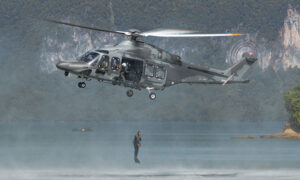
We love intel ahead of time. Before I was sent to do HUET for the first time, I was keen to know what the training involves, I looked up some insights/ personal recount of the process, not surprisingly, there’s very limited information out there. To reduce your level of anxiety before HUET, I’ll give you some brief ideas of what lies ahead.
Please note that the information below is based on my opinions only and does not necessarily represent the views of the private/ government organization that I work with. The intent is to provide you with some general information only, specific details should be based on the joining instructions from your training provider.
HUET is an essential periodic training for people who are required to fly in helicopters as part of their jobs. It provides you with the necessary techniques for exiting the aircraft in the event of the helicopter ditching into the water. The frequency of training depends on your organization, mostly every 2-4 years.
There are a few different types of HUET, technically HUET for aircrew and non-aircrew (people who don’t fly in helicopters on a regular basis). Most courses involve Emergency Breathing System (EBS) but some are done without, for various reasons. We’ll talk a bit about that later.
HUET is conducted in your flight suit/ uniform that you will flying with, or long pants/sleeves if you are not required to wear a uniform. For aircrew HUET, students are likely required to wear their aviation gloves and boots during the training, the aviation ensembles will be provided by the trainer. For non-aircrew HUET, you may wear your closed runners/ diving shoes, and be prepared to swim a short distance while in uniform with shoes. If you haven’t done this before, I would strongly encourage you to try swimming while fully clothed with shoes in a swimming pool before attending the training. If you are a strong swimmer, it should be an issue. However, if you are an average swimmer or below, try to work on effective strokes and postures while swimming would get you past the mark in the shortest timeframe. You may hire a swim instructor if you require further assistance. The HUET instructors will ask about your confidence in swimming, don’t be afraid to flag it to the instructors that you need help, it is an adult learning environment and they will look after you.
Also don’t be afraid to tell us about your fear of water, claustrophobia and not being able to equalize in the ears during HUET Medical, we will be able to provide recommendations to get you through this.
On the day of the training, you will be shown videos of near misses involving a helicopter, at the end they will show you another short video of a US Marines SGT (apology if I get your rank incorrect, and Bravo Zulu on promotion) who successfully escaped the aircraft in the dark, when it was sinking- “OK kids, that’s the reason you do HUET”, in the voice of Krusty the clown.
If your training involves Emergency Breathing System (EBS), the first part of the course focuses on the fundamentals of diving- check the cylinder before you use it, how to activate the regulator (mouthpiece) underwater, and EXHALE on ascend. If you are not able to pop your ears (to equalize the pressure between the middle and outer ear on the day due to flu-like symptoms or allergies, seek medical advice before the course, not after.
After Diving 101, you will perform the drills of escaping from a cage that looks a bit like… the mini MOKE, or a commode chair built inside a 4-legs walking frame. You will be the only student in the cage with 2-3 instructors around you, who will dunk turn the cage over to simulate the fuselage of a sinking helicopter. A few points here:
If the hatch/ window was on your left-hand side, it will be on your left-hand side after flipping over.
You will be tested on those drills blindfolded.
Your nasal cavity and sinuses will be filled with water after a few runs.
Hand signal to the instructors if you wish to stop the scenario. They will un-turn the cage and get you out immediately.
Once you are comfortable with the techniques, it’s time for the main course- to perform the drills with 4-6 other students in a simulated aircraft, it may not be the same fuselage as the aircraft that you fly in but essentially most helicopters are designed in a similar manner. You will be required to escape from various part of the aircraft, like the flight deck/ passenger seat/ cargo space etc. Remember the location of nearest exit (PORTSIDE or STARBOARD, FWD or AFT). Talk to the students you will be working with, be crystal clear as who is tasked to open the hatch (typically the person closest to the exit, but please do NOT assume). Injuries/ bad outcomes tend to happen when people don’t communicate.
As mentioned before, you will be blindfolded for some of the serials and in the final assessment. Most training centers are capable of adding in some real-world challenges such as changing the sea state (how rough the sea is) and weather conditions (rain/ wind) as part of the simulation.
There may be a session on sea survival before closing the course, when you will be in an inflated life jacket at all times, after jumping down from a 3meters platform (to simulate jumping from helicopter into the sea).
And… it’s home time. Generally, it’s recommended not to fly for 12-18hrs after using compressed air (diving), you may need to consider accommodating (and celebration locally) after the course. Also not to exercise intensely for at least 6hrs after diving, roaming the local street in a walking pace is ok. Empty the water in your nasal cavity and sinuses by leaning forward (by touching the toes), and seek medical attention if required.
Hope that helps and all the best with your HUET.
About the author
Dr. Armand Edison graduated from Melbourne University Medical School in 2008 and completed an internship and residency at Westmead Hospital, since then he worked at various locations ranging from Regional Trauma Facilities to solo Emergency Units both locally and overseas for 5 years. He has extensive experience in treating minor trauma and performing emergency procedures as required.
Dr. Edison is also a qualified Underwater Medicine Medical Officer and Aviation Medical Officer in the Royal Australian Navy, his job role involves treating various acute and chronic injuries in the elite athlete population on a daily basis.
Special interests: Dive Medicine, Aviation Medicine, Sports Injury, Emergency Medicine






